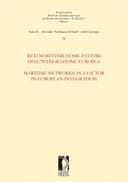Explore

Reti marittime come fattori dell’integrazione europea / Maritime Networks as a Factor in European Integration
Giampiero Nigro
2019
0 Ungluers have
Faved this Work
Login to Fave
This wide-ranging theme takes Braudel’s concept of the “Mediterranean” as its starting point. Braudel’s vision of an enclosed sea as a geographical opportunity for economic integration between nations with different religions, languages and ethnicities and political bodies still functions as a model for studies on a wide range of contexts. The goal of the 50th Study Week was to go beyond the study of individual systems in isolation, and to combine instead different analysis of open and enclosed seas or coastal areas in order to understand the integration role played by maritime connections in Europe. Since in pre-industrial civilizations water transport was easier than land transport, the time has come to bring attention to the way these relationship networks operated both on a European level and with Asian and North African trade partners. This volume starts from the great research traditions which have, however, rarely been integrated on a larger and continental scale, and analyses them on either a regional or thematic basis. Immanuel Wallerstein has developed Braudel’s concept by conceptualising its intercultural and transnational dimensions and its role in the system of labour. He called it a "world system", not because it involves the whole world, but because it is larger than any legally defined political unit. And it is a "world economy" because the base link between the different parts of the system has an economic nature. The various regional research aspects and traditions have been linked together in a coherent approach which aims at evaluating: - What geographical, nautical, technical, economic, legal, social and cultural elements influenced the emergence of the various regional networks, and how these worked; - The nature and role of seaports as nodal points of sea routes and of their hinterland through rivers, canals and roads; - The commercial and personal ties between merchants and shipowners in various ports; - How regional networks connected with each other and how, over time, they ended up integrating into larger units; - How private networks, initially between merchant and seafarer organizations, ended up dealing with local authorities and, after their growth, with states and empires in order to protect their interests.
This book is included in DOAB.
Why read this book? Have your say.
You must be logged in to comment.
Rights Information
Are you the author or publisher of this work? If so, you can claim it as yours by registering as an Unglue.it rights holder.Downloads
This work has been downloaded 163 times via unglue.it ebook links.
- 63 - pdf (CC BY) at Unglue.it.
- 100 - pdf (CC BY) at fupress.com.
Keywords
- Europe
- maritime networks
- maritime trade
- Mediterranean
- Middle Ages
- Modern Age
Editions

